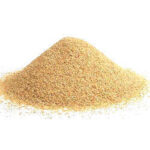Alumina Cement
We are the stalwarts in the domain of manufacturing, supplying, wholesaling, and exporting Alumina Cement These flavor grade chemicals are processed using pure and accurate ingredients that are procured from reliable and trusted vendors of the market. Our range is available in the market at leading prices in packs of different quantities.
Alumina Cement, also known as calcium aluminate cement (CAC) or high-alumina cement (HAC), is a specialized type of cement with high alumina content. It is primarily used in specific applications where high strength, rapid setting, and resistance to aggressive environments are required.
Here are some common uses and applications of alumina cement in construction:
Refractory linings: Alumina cement is widely used in the construction of refractory linings for high-temperature applications such as kilns, furnaces, and industrial incinerators. It offers excellent heat resistance, chemical resistance, and low thermal conductivity.
Precast products: Alumina cement is used in the production of precast concrete products that require high early strength and rapid setting. Examples include precast beams, panels, pipes, and tiles.
Rapid repair materials: Due to its fast-setting properties, alumina cement is used for quick repairs an

d patching of damaged concrete structures. It can be employed to repair cracks, spalls, and other defects in a short period of time.
Underwater construction: Alumina cement is useful for underwater construction projects where traditional Portland cement may not set or harden properly. It can be used for underwater grouting, repairs, and construction of marine structures.
Acid-resistant applications: Alumina cement is resistant to a wide range of acidic environments, making it suitable for acid storage areas, chemical processing plants, and wastewater treatment facilities. It provides protection against corrosion caused by acidic substances.
High-strength applications: Alumina cement has higher compressive strength compared to regular Portland cement. It is used in applications that require high strength, such as high-rise buildings, bridges, and heavy-duty industrial floors.
Sewer pipe construction: Alumina cement is used for the manufacturing of corrosion-resistant sewer pipes, especially in aggressive soil conditions where traditional cement-based materials may deteriorate.
It’s important to note that alumina cement has some limitations, such as high heat generation during curing and a tendency to shrink during setting. Therefore, it is crucial to follow proper handling and curing procedures and ensure compatibility with other construction materials when using alumina cement.
To use Alumina Cement for Crucibles, you can follow these general steps:
1.Crucible Design: Determine the desired size and shape of the crucible based on your specific application requirements.
2.Crucible Mold Preparation: Prepare a mold using a suitable material, such as metal or refractory material, that can withstand the high temperatures involved in the cement curing process.
3.Mixing: Mix the Alumina Cement with water. The ratio of cement to water may vary depending on the specific product, so refer to the packaging or product data sheet for accurate proportions.
4.Application: Apply the Alumina Cement mixture to the prepared crucible mold. You can use a trowel, spatula, or brush to ensure an even coating on the mold surface. Pay attention to corners and edges to ensure proper coverage.
5.Curing: Allow the applied Alumina Cement to cure. This typically involves air drying for a specific period or subjecting the crucible to a controlled heating process. The curing process is crucial for the cement to harden and develop its desired properties.
6.Optional Reinforcement: Depending on the size and application of the crucible, you may reinforce it with additional materials such as ceramic fibers or metal inserts. These reinforcements enhance the crucible’s structural integrity and resistance to mechanical stress.
7.Final Curing: After the initial curing, it is recommended to subject the crucible to a gradual heating process to further strengthen and stabilize the Alumina Cement, this process, known as heat treatment or annealing, can involve controlled temperature ramps and holding at specific temperatures for a defined duration.
8.Cooling and Preparation: Once the final curing process is complete, allow the crucible to cool down gradually to room temperature. Carefully remove it from the mold and inspect it for any cracks or defects. If necessary, perform any additional finishing or surface treatments to ensure the crucible is ready for use.








